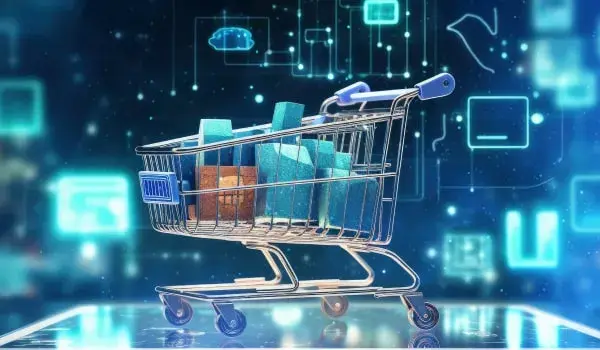When you’re ready to prioritize speed-to-market, user experience, and the need for ongoing innovation – it’s time to migrate from monolithic E-commerce to headless E-commerce. In this article, we'll examine the difference between the two and how to seamlessly incorporate a new system architecture into your workflow.
The world of E-commerce is changing at a sometimes breathtaking pace. In fact, it could now be said that E-commerce is on its way to becoming increasingly automatic. As consumers become accustomed to consuming content and making purchases across various touchpoints – from IoT devices to advanced web applications – the challenge for businesses and E-commerce operators today is to keep pace with the demands and desires of customers and competitors.
When you’re ready to prioritize speed-to-market, user experience, and the need for ongoing innovation – it’s time to migrate from monolithic E-commerce to headless E-commerce. In this article, we'll examine the difference between the two and how to seamlessly incorporate a new system architecture into your workflow.
What Does Headless Architecture Consist Of?
Headless architecture in software development refers to a design approach that decouples the frontend, which is responsible for the user interface (UI), from the backend, which handles the business logic of a website or application.
Who benefits from headless commerce? In short, it is all about companies that want to engage customers faster with innovative experiences at all touchpoints. Headless commerce is now an option for all companies that strive for a better and more individualized customer experience – even those without large in-house development and IT teams. Regardless of company size, 57% of digital top performers plan to implement a headless architecture within the next two years.
A typical headless commerce platform comprises various components, often the frontend, commerce platform, content management system (CMS), search, and payment. Let’s examine each layer in more detail.
Frontend
The frontend layer presents the user interface (UI) to the website visitors or application users. It includes components such as web pages, interactive elements, and user interface design. In headless architecture, the frontend is detached from the backend, enabling developers to use any frontend technology or framework to build engaging user experiences without being constrained by the backend technology.
Commerce platform
The headless commerce platform is the backend system responsible for managing core E-commerce functionalities such as product catalog, inventory tracking, pricing, and order processing. It provides APIs that allow the frontend to interact with the backend services, enabling seamless integration with various frontend interfaces while maintaining centralized control over E-commerce operations.
CMS (Content Management System)
A headless CMS manages and delivers content to the frontend interface. It allows content creators and marketers to create, edit, and organize digital content such as text, images, videos, and product descriptions without being tied to a specific presentation layer. With headless CMS, content can be delivered across multiple channels and devices, offering greater flexibility and consistency in content management.
Search
The search layer facilitates efficient and accurate search functionality within the E-commerce platform. It lets users quickly find products, categories, or content based on their search queries. In a headless architecture, the search functionality is decoupled from the frontend, allowing customization and integration with different search engines or algorithms to optimize the search experience.
Payment
The payment layer handles the processing of online transactions, such as payment authorization, capturing funds, and generating payment receipts. It integrates with payment gateways and third-party payment processors to securely handle payment transactions. In a headless architecture, the payment functionality can be integrated seamlessly into the checkout process, providing customers with a smooth and secure payment experience across various frontend interfaces.
By keeping these layers separate in a headless architecture, businesses gain the flexibility to innovate and adapt quickly to changing market demands while still maintaining centralized control over core E-commerce operations.
Monolithic and Headless Architectures: Key Differences
Why compare monolithic and headless E-commerce architectures? Understanding the differences between these approaches is crucial for businesses navigating E-commerce development.
Compared to platforms that follow a conventional approach, a headless commerce platform does not have its own user interface (UI). Therefore, it cannot be directly accessible to end users. Content only becomes visible for end users to consume when a corresponding UI is provided. The UI is not part of the headless commerce platform, but rather is provided as independent software – the so-called frontend. This software is connected to the headless commerce platform via an API (Application Programming Interface).
API is an application programming interface used to deliver content. This software acts as an intermediary between the frontend and the backend. This method enables much faster deployment than traditional E-commerce platforms and ensures excellent customer experiences.
API allows the UI developer to call up the services offered by the headless commerce platform and thus make their functionalities accessible to the end user, depending on the end device used. These functionalities can include, for example, the display and purchase of products, corresponding customer reviews, or access to blog posts.
Now, let’s examine other differences between the monolithic and headless E-commerce architectures.
| Aspect | Monolithic architecture | Headless architecture |
| Responsiveness | Typically, less flexible and slower to adapt to changing frontend needs. | Highly responsive and adaptable due to the separation of frontend and backend layers. Frontend updates can be made independently. |
| Structure | Unified architecture where frontend and backend are tightly coupled. | Decoupled architecture where frontend and backend are separated, allowing for independent development and deployment. |
| Scalability | Scaling can be challenging, as the entire application needs to be scaled together. | Offers greater scalability as frontend and backend components can be scaled independently based on demand. |
| Flexibility | Limited flexibility in choosing frontend technologies or frameworks. Changes to the frontend require modifications in the backend. | Offers flexibility in choosing frontend technologies. Frontend can be updated or changed without impacting backend functionality. |
Headless Commerce Integration
SAP recently announced significant changes for SAP Commerce, including deprecating the Accelerator UI & OCC v1 and v2 template extensions. Additionally, SAP Commerce 2205 marks the final on-premise release, with a full transition to a cloud-native solution ahead. While mainstream maintenance for SAP Commerce 2205 will continue until July 31, 2026, business template-based Accelerator UI implementations are urged to take action sooner rather than later.
The crucial takeaway is the uncertainty surrounding the compatibility of Accelerator UI templates with future SAP Commerce releases. To mitigate risks, businesses must transition to a headless solution, separating the storefront UI from its underlying code. This move to embrace SAP Commerce in the cloud ensures future adaptability and aligns with SAP's strategic direction.
As companies transition to headless architecture, LeverX's experienced technical team can help merge existing software infrastructure with the new setup. With our rich background in SAP implementation and integration, along with a solid grasp of headless architecture, LeverX is well-equipped to assist. We'll guide companies through each transition stage, from initial assessment to API integration, frontend development, and testing.
Our expertise ensures a smooth and successful adoption of headless solutions, allowing businesses to confidently evolve their digital commerce infrastructure. Generally, the development timeline will be based on five key components of your headless solution:
- Customer management
- Commerce management
- Supplier management
- Integrations management
- User experience
Here are the steps we will take to improve your E-commerce performance:
1. Assessment and planning:
- We will conduct a comprehensive assessment of your current E-commerce setup, identifying areas for decoupling to implement headless architecture.
- Our team will work closely with you to define clear goals and objectives for the integration, ensuring alignment with your business objectives.
- Based on our assessment, we will create a detailed integration plan outlining the steps, timeline, and resources required for a successful implementation.
2. Selecting headless technologies:
- We will leverage our expertise to research and recommend the most suitable headless commerce platform or CMS for your specific requirements.
- Our team will guide you through the selection process, considering factors such as flexibility, scalability, and integration capabilities.
- We will help you choose frontend frameworks or technologies that align with your development team's skill set and desired user experience.
3. API integration:
- Our experienced developers will seamlessly integrate your chosen headless commerce platform with your existing systems and databases.
- We will develop or configure API endpoints to enable smooth communication between the frontend and backend systems, ensuring secure authentication and authorization.
4. Frontend development:
- Our design and development experts will craft a visually appealing and user-friendly frontend experience using the selected technologies.
- Leveraging the APIs provided by the headless commerce platform, we will implement features such as product browsing, cart management, and checkout processes.
- We will prioritize responsive design principles to ensure optimal performance and usability across various devices and screen sizes.
5. Testing and optimization:
- Before deployment, our quality assurance team will conduct rigorous testing to identify and address any bugs or performance issues.
- We will perform comprehensive testing across different environments, ensuring compatibility and responsiveness.
- Post-launch, we will continue to monitor and optimize the system based on analytics and user feedback, ensuring ongoing performance, security, and user satisfaction.
With our expertise and dedicated support, we will guide you through each step of the integration process, delivering a robust and scalable headless commerce solution tailored to your business needs.
Conclusion
By leveraging LeverX's technical proficiency and strategic insights, companies can navigate the transition to headless solutions with confidence. LeverX's tailored approach ensures that businesses not only mitigate risks associated with SAP Commerce Cloud updates but also unlock the full potential of headless architecture.
Our 20-year experience working with SAP enables entrepreneurs to deliver seamless and engaging E-commerce experiences to their customers while future-proofing their digital commerce infrastructure. So, if you want your breakthrough digital transformation strategy in E-commerce, fill in the form below to contact our team.
How useful was this article?
Thanks for your feedback!



